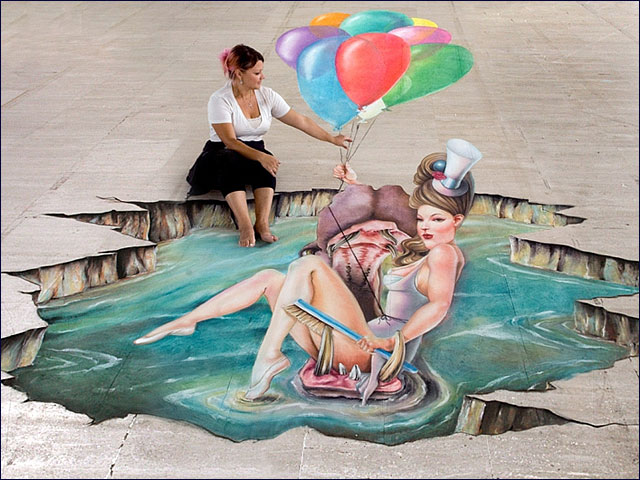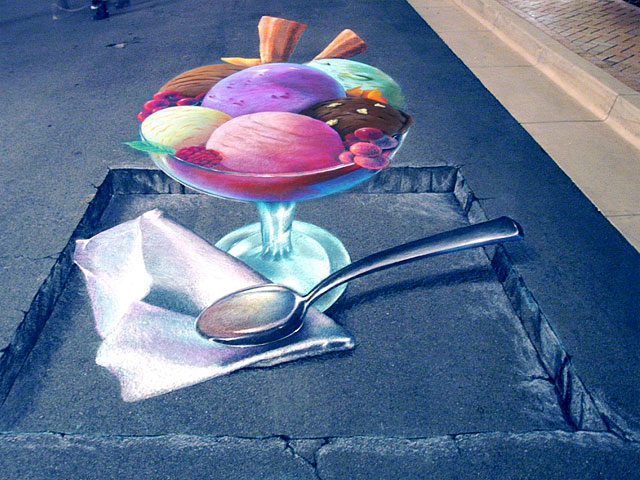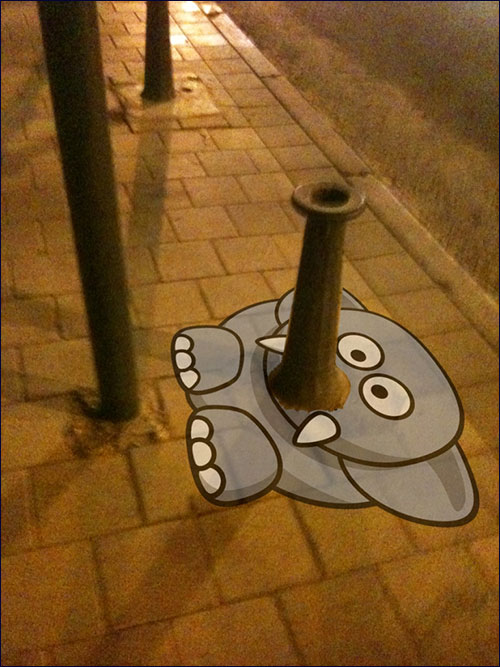By Avigayil Kadesh
To celebrate the 90th anniversary of Tel Aviv suburb Ramat Hasharon, Israeli and foreign artists will use 3D chalk drawings to transform Bialik Street into an urban art compound.
Street artists, painters and musicians from Israel as well as from Holland, Italy, the United States and Russia are contributing their talents to the inaugural Ramat Hasharon International Festival, to run from July 11-13 in the Mediterranean coastal city of about 41,000 citizens.

Chalk picture by We Talk Chalk artist Melanie Stimmell Van Latum
In cooperation with the international street-painting company
We Talk Chalk, the artists will decorate the city center with dozens of lifelike graffiti and sidewalk drawings. Other artists will embellish walls, cars and motorcycles, while painters and sculptors of differing styles will demonstrate their craft.
“We wanted to take the activity one step ahead of all other Israeli cities,” says Guy Calner, a city council member who is chairing the 90th anniversary celebrations.
“This city is unique and special with a lot of culture, but 3D sidewalk art is something new to Israel as far as we know. We want to be the pioneers.”
Festival director Eli Sagi adds, “This is a defining moment in the development of culture in Ramat Hasharon, and I believe that the festival will make a name for itself and attract large crowds from all over the country.”
International flavor
Sagi was the one who brought up the idea of 3D sidewalk art, a genre that is gaining popularity in cities around the world. When he showed photos of creations by We Talk Chalk artists to the festival planners, they agreed it would be perfect for the event.
They also liked the idea of bringing over artists from abroad. “We think this is very appropriate for Ramat Hasharon,” says Calner. “The collaboration between overseas artists and Israeli artists will make a better picture for us because it gives another way to view art and culture.”

Chalk picture by We Talk Chalk artist Melanie Stimmell Van Latum
He expects up to 50,000 Israelis to come over the course of the festival, including Israel’s President Shimon Peres. It will be open from 6 to 11 pm on Wednesday and Thursday, and on Friday from 10 am to 3 pm. “Our activities are always spilling over the city borders, attracting people who come from Tel Aviv, Herzliya and other areas,” Calner says.
Among other big draws in Ramat Hasharon is the extravagant Purim parade held every spring. As the home of HaMidrasha, an art teachers training college, Ramat Hasharon has plenty of local talent.
The free festival will also highlight live musical performances by Israeli singing star Rita (a resident of Ramat Hasharon), the local symphony orchestra and an ensemble from the city’s renowned Rimon School of Jazz and Contemporary Music.
In addition to 3D chalk art, the festival will spotlight contemporary works by Israeli artists such as airbrush artist Elad Kodenchik, who applies his talents to cars and motorcycles; and the Hey Design group that uses recycled materials like rusty pipes and detergent bottles to make street sculptures. Hadas Itzkovitz of Haifa, a graduate of the Holon Institute of Technology and the Technion Israel Institute of Technology, will show off her ecological creations meant to raise public awareness of environmental issues.

Hadas Itzkovitz’s sidewalk art uses recycled materials.
“The city of Ramat Hasharon places great emphasis on the development of art and culture,” said Mayor Itzik Rochberger. “No doubt this festival is the only one of its kind, combining international artists along with Israeli artists in an urban public space for three days.”
For now, there’s been no push to market the festival to foreign tourists, but that will probably change next year.
“It’s ambitious to expect tourists to come the first year, but we want to build a strong foundation and make it one of the well-known activities in Israel for the future,” says Calner.